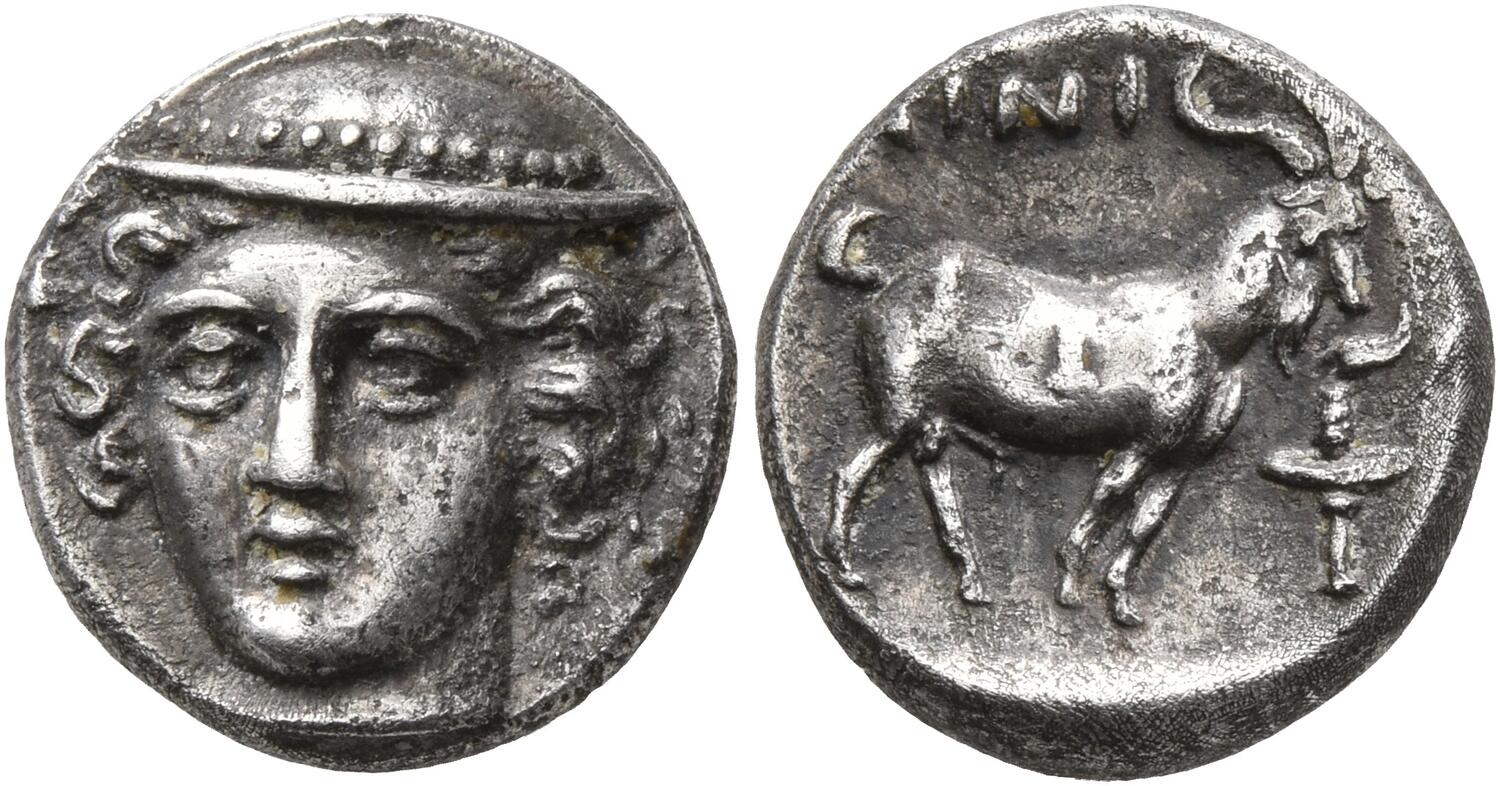AC 114 - Aenus, silver, tetrobols (405/4-359/8 BCE)
From SILVER
404 BCE - 358 BCE Silver 1,799 kg
Description
| ObverseInscription or printing placed on the obverse.: | Head of Hermes facing slightly to left, wearing petasos. |
| ReverseInscription or printing placed on the reverse.: | AINION (Greek).AINION Male goat standing right, to lower right, race-torch, all within incuse square. |
Mint and issuing power
| MintIdentifies the place of manufacture or issue of a numismatic object.: | Aenus | Ancient regionAncient region.: | Thrace | Modern countryModern country: Greece | AuthorityIdentifies the issuing power. The authority can be "pretended" when the name or the portrait of X is on the coin but he/she was not the issuing power. It can also be "uncertain" when there is no mention of X on the coin but he/she was the issuing power according to the historical sources: |
Chronology
| FromIdentifies the initial date in a range assigned in a numismatic context. | 404 BCE | toIdentifies the final date in a range assigned in a numismatic context.. | 358 BCE | PeriodTime period of the numismatic object.: Classical 480-323 BC |
Physical description
| MetalThe physical material (usually metal) from which an object is made.: | Silver |
Median weightMedian of the weights of numismatic objects (in grams). in grams | 2.40 | DenominationTerm indicating the value of a numismatic object. Examples: tetradrachm, chalkous, denarius.: | tetrobol |
StandardStandard.: |
Image

AC114 Aenus.jpeg [1]
References
| Die study referencePublication of the study: | May 19501May 1950 | ||
| Coin series referenceReference to coin series study: | RQEMAC2RQEMAC, n° 114 | ||
Obverse dies distribution
| FrequencyFrequency of specimen in distribution. ᵖ | Number of obversesNumber of obverse dies. ᵖ (o) | % (o) | Number of coinsNumber of coins. (n) | % (n) | Die nameName(s) of the die(s). |
| 1 | 11 | 50 | 11 | 26.19 | 196, 208, 213, 284, 220, 225, 231, 232, 237, 250, 253 |
| 2 | 6 | 27.27 | 12 | 28.57 | 214, 221, 223, 229, 234, 258 |
| 3 | 3 | 13.64 | 9 | 21.43 | 219, 222, 256 |
| 5 | 2 | 9.09 | 10 | 23.81 | 233, 252 |
| Total | 22 of 22 | 100 | 42 of 42 | 100 |
Reverse dies distribution
no distribution is available
Quantification
| Number of obversesNumber of obverse dies. ᵖ (o) | 22 | Number of singletons (o1)The number of singleton coins. ᵖ | 11 |
| Number of reverse diesNumber of reverse dies. (r) | Number of coinsNumber of coins. (n) | 42 | |
| Coins per obverse dieNumber of coins per obverse die. (n/o) | 1.91 | Coins per reverse dieNumber of coins per reverse die. (n/r) | |
| Reverse per obverse ratioRatio of obverse dies divided by reverse dies. (r/o) | Percentage of singletons (o1)number of coins (n) divided by the number of singletons (o1) ᵖ | 50 % | |
| Original number of dies (O) (Carter 1983 formula)The estimation of the number of coins according to Carter 1983 ᵖ | 37.48 | Coins struck if 20,000 as average productivity per dieCoins made if the average productivity for obverses (according to Carter) is 20,000. ᵖ | 749,600 |
| Original number of dies (O) (Esty 2011 formula)The estimation of the number of coins according to the singleton formula in Esty 2011 ᵖ (O) | 46.2 | Survival rate if 20,000 as average productivity per dieSurvival rate if average productivity is 20,000. ᵖ | 0.00006 |
| Coverage (o = % of O) (Esty 1984 formula)Esty 1984 - coverage (% of O) ᵖ (o = % of O) | 73.81% | Die productivity if survival rate 1/2,000Average productivity if survival rate is 1/2,000. ᵖ | 2,241.2 |
| Weight of silver (in kg) if 20,000 coins per die (O = Carter formula)Carter 1983 * Median weight * 20000 (*10 if gold or electrum) ᵖ | 1,799 kg <br /> 1,799 kg | Die productivity if survival rate 1/5,000Average productivity if survival rate is 1/5,000. ᵖ | 5,602.99 |
Remarks
Most likely one single workstation